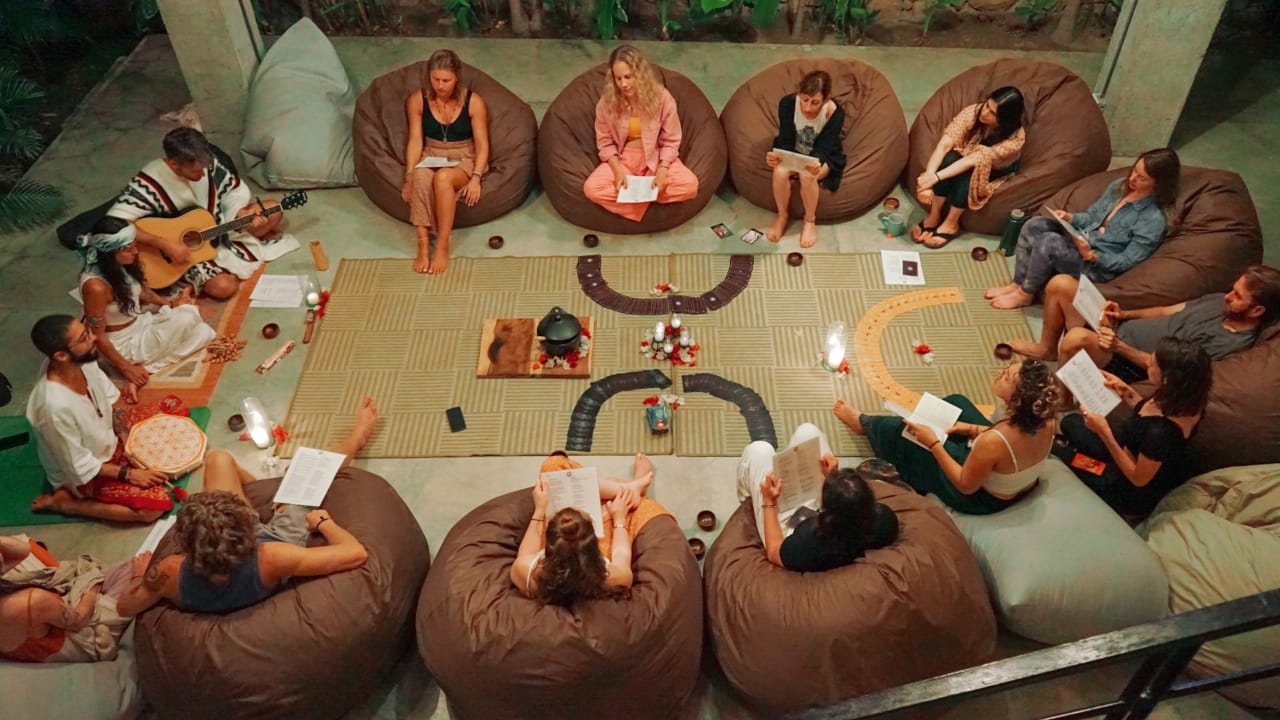
Discovering the Heart of Yoga: The Power of Bhakti Beyond the Mat

Even before stepping into my first yoga class, I held a preconceived notion of what yoga should be: a group engaging in stretching exercises, striking fancy poses, and practicing breathing exercises on their mats, culminating in everyone leaving with a big smile. Surprisingly, my initial experience with yoga mirrored this expectation: flowing through sequences of various poses on my mat helped me disconnect from my thoughts and heightened my awareness of my body. I found satisfaction in this practice initially, yet sensed an important element was absent.
By serendipity, years later, I stumbled upon a Kirtan, a live music event featuring mantras. At the time, I had little understanding of what it meant. Nonetheless, I attended with a friend, and it profoundly altered my perspective on yoga.
Engaging in mantra chanting and devotional singing allowed me to access my heart. What I mean by this is that, through this practice, I experienced for the first time the essence often described in yoga as ‚union‘. Chanting repetitively with closed eyes in a group setting opened an entirely new dimension for me, revealing the true meaning of yoga: self-realization through connection with others. Surrendering control and simply following the sound created a profound sense of an open heart.
It wasn’t until years later that I came to the realization that yoga transcends the physical practice of asanas on the mat. The genuine magic of yoga, for me, lay hidden in the realm of music. Chanting mantras is integral to what is known as ‘Bhakti.’ But what exactly is Bhakti? It’s an alternative approach to practicing yoga—a less conventional yet undeniably powerful one.
There are four ways of Yoga as the ancient philosophy says:
-
Raja Yoga: The path of control. In this practice, you bring body, mind, and breath under control to let go of ego and realize the Self. Including the practice of asanas, is a part of Raja Yoga.
-
Jnana Yoga: The path of knowledge. In this practice, you surrender your ego through acquiring knowledge, which removes ignorance and illusion and leads to understanding the reality of the Self.
-
Karma Yoga: The path of selfless duty. When you follow this path, you do your duty to the best of your abilities, without attachment to results or rewards. This helps you let go of your ego and leads to Self-realization.
-
Bhakti Yoga: The path of devotion to the Divine. This is the path of surrendering your ego to whatever is your perception of Divinity. In this way you start to realize the reality of the Self.
Among the millions of yoga practitioners worldwide, a significant majority gravitates towards Raja Yoga. Well-known styles such as Ashtanga Vinyasa, Hatha, Hot Yoga, and Iyengar predominantly fall under the category of Raja Yoga, emphasizing the practice of asanas and pranayama. However, within this diverse landscape, there are a few styles that embrace a more expansive approach, incorporating mantra chanting and rituals into their practice. Particularly notable in the Kundalini and Tantra traditions, Bhakti Yoga assumes a central role, adding a dimension of devotion and spiritual connection to these unique yogic paths.
Raja or Bhakti Yoga? Both are leading into the same direction through Kundalini
These styles work with the energy body, which means we set other forces in motion within us through Kriyas, which combine movement sequences, breathing exercises and mantras. These exercises activate our kundalini, the snake power within us, or also called shakti energy. As soon as the internal blockages are released and this energy rises, we experience ourselves and our environment with completely different eyes. Bhakti helps to open the heart space and clear the path of Kundalini to rise to the third eye, the place of our intuition and divine connection. In other words, through Bhakti, instead of following the mind-directed ego we follow our heart, we learn to experience ourselves as part of this miracle through trust and surrender to the universal consciousness.
My spiritual journey through yoga really began through Bhakti. Raja Yoga such as Hatha piqued my interest and prepared my body and mind. Bhakti has also helped me to fully commit to my daily routine and practice devotion. Hatha and Bhakti are going hand in hand for me. It was the music that first drew me to what all the old traditions and books of Yoga say: Yoga is the path of liberation through which we connect with the divine. In many spiritual traditions, sound is considered sacred and is believed to have the power to connect individuals with higher states of consciousness. The repetition of Sanskrit mantras is seen as a way to attune the mind and body to these higher frequencies. But all of this is hard to comprehend if you haven’t experienced it. So lets check the history and facts first: It starts with the ancient language of India, called: Sanskrit
Why should I always repeat the same words?, I asked myself in the beginning
The practice of chanting Sanskrit mantras is deeply rooted in ancient Indian spiritual and philosophical traditions. The power attributed to Sanskrit mantras is often associated with the vibrational quality of the sounds and the specific phonetic structure of the language.
Chanting these mantras is thought to produce specific vibrations that can resonate with certain energy centers, we call Chakras, in the body, promoting a sense of well-being and balance. In Kundalini for example we work specifically with each Chakra. Certain frequencies allow us to activate those energy centres.
Chanting Sanskrit mantras often involves rhythmic breathing patterns. There is the connection to Pranayama, breath control and techniques, which is a major part in Kundalini too. This breathing patterns have a calming effect on the nervous system, promoting relaxation and reducing stress. The combination of sound and breath is considered a powerful tool for meditation and mindfulness. Singing in the morning is actually a perfect preparation to dive deeply into meditation afterwards. In the Evening its calms us down to feel ready for bed and rest.
It’s a form of mantra meditation, where the mind is focused on the sound and meaning of the mantra. This helps quiet the mind, reduce mental chatter, and create a sense of inner peace and concentration.
And then there is also the community aspect. Singing in groups creates even a bigger impact. Mantras have been passed down through generations. It connects people on another level of being. Chanting these mantras is not only a personal practice but also a way of connecting with the spiritual lineage and invoking the blessings associated with the tradition.
Kirtan is a spiritual party – without drugs but with ecstasy
Apart of the mantras we use in Kundalini those songs are also used in Kirtans. Kirtan is a devotional practice. It is a form of call-and-response singing, where a leader sings a line or verse, and the participants respond by repeating the same line. Kirtan is often accompanied by musical instruments such as harmonium, guitar and other instruments.
The practice of Kirtan is not just a musical performance; it is intended to be a spiritual experience. Through chanting and singing, we can invoke the divine presence and experience a deep connection with the spiritual realm. Kirtan sessions can sometimes lead to a state of heightened emotion and ecstatic energy. joy, bliss, or inner peace are possible feelings.
What all this Bhakti is about for me
In essence, music possesses spiritual and transcendent qualities, serving as a wellspring of inspiration that connects individuals to a sense of purpose and a higher power. This essence encapsulates Bhakti, the devotional path of Yoga that fosters connection. Yet, within this journey, there is much more to explore, including sacred rituals and Japa-Mala-Prayers. However, delving into these aspects proves challenging to articulate; they are best understood through personal experience. The beauty of Bhakti lies in the profound significance of one’s encounters. Without firsthand experience, words remain mere expressions. This is the allure of Bhakti: irrespective of personal beliefs or the timbre of one’s voice, an open mind, a humble heart, and unwavering devotion pave the way effortlessly in this Yogic journey. For me, Hatha Kundalini and Bhakti are inseparably linked.

Palomino, Caribbean Coast
50 hr Hatha Kundalini Bhakti
Yoga Teacher Training
20th – 27th of May 2024
EARLY BIRD OFFER!
Welcome to the embrace of paradise, where we shall find ourselves enveloped in the serene splendor of a newly unveiled Caribbean beachfront eco wellness sanctuary resort. Elevate your practice to new heights as we delve into the transformative power of Kundalini, forging a profound connection with Tantra, and igniting the flame of devotion through Bhakti. This 50 hours program is a registered course in Yoga Alliance that could be use for continuing education program.
Contact
Don’t hesitate to reach out to us!
We are happy to hear from you!